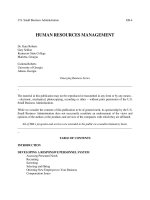human resources management _ section 2-hr planning and job analysis
Bạn đang xem bản rút gọn của tài liệu. Xem và tải ngay bản đầy đủ của tài liệu tại đây (2.27 MB, 56 trang )
Human Resource
Management
ESSENTIAL PERSPECTIVES
© 2005 Southwestern College Publishing. All rights reserved.
PowerPoint Presentation
by Truong Thi Lan Anh
Human Resource planning and
Job analysis
Section 2
Robert L. Mathis John H. Jackson
© 2005 Southwestern College Publishing. All rights reserved. Lan Anh 2–2
Learning Objectives
After you study this section, you should be able to:
– Define HR planning, and outline the HR planning
process.
– Identify factors to be considered in forecasting the
supply and demand for human resources in an
organization.
– Discuss several ways to manage a surplus of human
resources.
– Identify what a human resource information system
(HRIS) is and why it is useful when doing HR planning.
© 2005 Southwestern College Publishing. All rights reserved. Lan Anh 2–3
Learning Objectives (Con’t.)
– Explain how changing job characteristics can be used
to improve jobs.
– Discuss different approaches to job analysis, e.g.
workflow, task-based, and competency analysis.
– List and explain four job analysis methods.
– Identify the five steps in conducting a job analysis.
– Write a job description and the job specifications for it.
Attracting
candidates
HR planning:
•Which positions/jobs are vacant?
•Which sources can provide candidates?
Job analysis:
•Which requirements to accomplish these positions/jobs?
© 2005 Southwestern College Publishing. All rights reserved. Lan Anh 2–4
Factors That Determine HR Plans
Figure 2–3
© 2005 Southwestern College Publishing. All rights reserved. Lan Anh 2–5
Human Resource Planning
Human Resource (HR) Planning
– The process of analyzing and identifying the need
for and availability of human resources so that the
organization can meet its objectives.
HR Planning Responsibilities
– Top HR executive and subordinates gather
information from other managers to use in the
development of HR projections for top management
to use in strategic planning and setting
organizational goals
© 2005 Southwestern College Publishing. All rights reserved. Lan Anh 2–6
Typical Division of HR Responsibilities
in HR Planning
Figure 2–5
© 2005 Southwestern College Publishing. All rights reserved. Lan Anh 2–7
Human Resource Planning (cont’d)
Small Business and HR Planning Issues
– Attracting and retaining qualified outsiders
– Management succession between generations of
owners
– Evolution of HR activities as business grows
– Family relationships and HR policies
© 2005 Southwestern College Publishing. All rights reserved. Lan Anh 2–8
HR Planning Process
Figure 2–6
© 2005 Southwestern College Publishing. All rights reserved. Lan Anh 2–9
HR Planning Process
HR Strategies
– The means used to anticipate and manage the
supply of and demand for human resources.
• Provide overall direction for the way in which HR
activities will be developed and managed.
Overall
Strategic Plan
Human Resources
Strategic Plan
HR Activities
HR Planning Process
Company
Strategy
What staff do
we need to do
the job?
What staff is
available
within our
organization?
Is there a
match?
If not, what type of
people do we need, and
how should we recruit
them?
Job Analysis
• Performance
appraisal
• Company data
banks
• Training
• Employee
management and
development
What is impact
on wage and
salary
program?
Source:
www.ExploreHR.org
© 2005 Southwestern College Publishing. All rights reserved. Lan Anh 2–11
Benefits of HR Planning
Better view of the HR dimensions of business
decisions
Lower HR costs through better HR management.
More timely recruitment for anticipate HR needs
More inclusion of protected groups through planned
increases in workforce diversity.
Better development of managerial talent
© 2005 Southwestern College Publishing. All rights reserved. Lan Anh 2–12
Scanning the External Environment
Environmental Scanning
– The process of studying the environment of the
organization to pinpoint opportunities and threats.
Environment Changes Impacting HR
– Governmental regulations
– Economic conditions
– Geographic and competitive concerns
– Workforce composition
© 2005 Southwestern College Publishing. All rights reserved. Lan Anh 2–13
Internal Assessment of the
Organizational Workforce
Auditing Jobs and Skills
– What jobs exist now?
– How many individuals are performing each job?
– How essential is each job?
– What jobs will be needed to implement future
organizational strategies?
– What are the characteristics of anticipated jobs?
© 2005 Southwestern College Publishing. All rights reserved. Lan Anh 2–14
Internal Assessment of the
Organizational Workforce
Organizational Capabilities Inventory
– HRIS databases—sources of information about
employees’ knowledge, skills, and abilities (KSAs)
– Components of an organizational capabilities
inventory
• Workforce and individual demographics
• Individual employee career progression
• Individual job performance data
© 2005 Southwestern College Publishing. All rights reserved. Lan Anh 2–15
Forecasting HR Supply and Demand
Forecasting
– The use of information from the past and present
to identify expected future conditions.
Forecasting Methods
– Judgmental
• Estimates—asking managers’ opinions, top-down or
bottom-up
• Rules of thumb—using general guidelines
• Delphi technique—asking a group of experts
• Nominal groups—reaching a group consensus in open
discussion
© 2005 Southwestern College Publishing. All rights reserved. Lan Anh 2–16
Forecasting HR Supply and Demand
Forecasting Methods (cont’d)
– Mathematical
• Statistical regression analysis—
• Simulation models
• Productivity ratios—units produced per employee
• Staffing ratios—estimates of indirect labor needs
Forecasting Periods
– Short-term—less than one year
– Intermediate—up to five years
– Long-range—more than five years
© 2005 Southwestern College Publishing. All rights reserved. Lan Anh 2–17
Forecasting
Methods
Figure 2–8
© 2005 Southwestern College Publishing. All rights reserved. Lan Anh 2–18
Forecasting HR Supply and Demand
Forecasting the Demand for Human Resources
– Organization-wide estimate for total demand
– Unit breakdown for specific skill needs by number
and type of employee
• Develop decision rules (“fill rates”) for positions to be
filled internally and externally.
• Develop additional decision rules for positions
impacted by the chain effects of internal promotions
and transfers.
Forecasting the Supply for Human Resources
– External Supply
– Internal Supply
© 2005 Southwestern College Publishing. All rights reserved. Lan Anh 2–19
Forecasting HR Supply and Demand
Forecasting External HR Supply
– Factors affecting external
• Net migration for an area
• Individuals entering and leaving the workforce
• Individuals graduating from schools and colleges
• Changing workforce composition and patterns
• Economic forecasts
• Technological developments and shifts
• Actions of competing employers
• Government regulations and pressures
• Other factors affecting the workforce
Forecasting Internal HR Supply
– Effects of promotions, lateral moves, and terminations
– Succession analysis Succession plan
© 2005 Southwestern College Publishing. All rights reserved. Lan Anh 2–20
Succession Planning Process
Figure 10–8
© 2005 Southwestern College Publishing. All rights reserved. Lan Anh 2–21
Example of A succession plan
President & CEO
Mr. Dũng
VP Human Resources
Ms. Phương
Mgr. HR Development
Ms. Lan Anh
Mgr. Employ.
Mr. Thanh
Mgr. Compen.
Mr. Hùng
Salary Analyst
Ms. Thảo
Benefits
Analyst
Ms. Hương
Promotion
Retirement
Promotion
Promotion
External Recruitment
Mr. Sơn
B.A., UEH
© 2005 Southwestern College Publishing. All rights reserved. Lan Anh 2–22
Estimating Internal Labor Supply for a Given Unit
Figure 2–9
© 2005 Southwestern College Publishing. All rights reserved. Lan Anh 2–23
Managing Human Resource
Surplus or Shortage
Workforce Realignment (cont’d)
– Positive consequences
• Increase competitiveness
• Increased productivity
– Negative consequences
• Cannibalization of HR resources
• Loss of specialized skills and experience
• Loss of growth and innovation skills
– Managing survivors
• Provide explanations for actions and the future
• Involve survivors in transition/regrouping activities
© 2005 Southwestern College Publishing. All rights reserved. Lan Anh 2–24
Managing Human Resource
Surplus or Shortage
Downsizing approaches
– Attrition and hiring freezes
• Not replacing departing employees and not hiring new
employees/
– Early retirement buyouts
• Offering incentives that encourage senior employees to
leave the organization early.
– Layoffs
• Employees are placed on unpaid leave until called back
to work when business conditions improve.
• Employees are selected for layoff on the basis of their
seniority or performance or a combination of both.
© 2005 Southwestern College Publishing. All rights reserved. Lan Anh 2–25
Managing Human Resource
Surplus or Shortage
Downsizing approaches (cont’d)
– Outplacement services provided to displaced
employees to give them support and assistance:
• Personal career counseling
• Resume preparation and typing services
• Interviewing workshops
• Referral assistance
• Severance payments
• Continuance of medical benefits
• Job retraining









